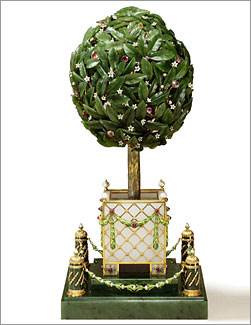The Orange Tree (Bay Tree) Egg
THE BAY TREE EGG: A FABERGÉ IMPERIAL EASTER EGG PRESENTED BY EMPEROR NICHOLAS II TO HIS MOTHER THE DOWAGER EMPRESS MARIA FEODOROVNA AT EASTER 1911
 The topiary tree formed as a profusion of carved nephrite, finely veined leaves and jeweled fruit and flowers on an intricate framework of branches, the fruit formed by champagne diamonds, amethysts, pale rubies and citrines, the flowers enameled white and set with diamonds, a keyhole and a tiny lever, hidden among the leaves, when activated open the hinged circular top of the tree and a feathered songbird rises, flaps its wings, turns its head, opens its beak and sings, the gold trunk chased to imitate bark and planted in gold soil is contained in a white quartz tub applied with a gold trellis chased with flowerheads at the intersections and further applied with swags of berried laurel enameled translucent green and pinned by cabochon rubies, the central rubies edged by diamonds, each foot of the tub also applied with chased gold rosettes set with cabochon rubies and diamonds, the corners of the tub with pearl finials, the square carved nephrite base in two steps with a miniature nephrite fluted column at each corner set with chased gold mounts, each column with a reeded gold cap surmounted by a pearl nestled in translucent green enamel leaves, the swinging gold chains between the columns formed as pearl flowers with translucent green enamel leaves, inscribed Fabergé in Cyrillic with the date 1911 on lower front rail of the tub.
The topiary tree formed as a profusion of carved nephrite, finely veined leaves and jeweled fruit and flowers on an intricate framework of branches, the fruit formed by champagne diamonds, amethysts, pale rubies and citrines, the flowers enameled white and set with diamonds, a keyhole and a tiny lever, hidden among the leaves, when activated open the hinged circular top of the tree and a feathered songbird rises, flaps its wings, turns its head, opens its beak and sings, the gold trunk chased to imitate bark and planted in gold soil is contained in a white quartz tub applied with a gold trellis chased with flowerheads at the intersections and further applied with swags of berried laurel enameled translucent green and pinned by cabochon rubies, the central rubies edged by diamonds, each foot of the tub also applied with chased gold rosettes set with cabochon rubies and diamonds, the corners of the tub with pearl finials, the square carved nephrite base in two steps with a miniature nephrite fluted column at each corner set with chased gold mounts, each column with a reeded gold cap surmounted by a pearl nestled in translucent green enamel leaves, the swinging gold chains between the columns formed as pearl flowers with translucent green enamel leaves, inscribed Fabergé in Cyrillic with the date 1911 on lower front rail of the tub.
First known in 1935 as a Bay Tree Egg, this egg which had since 1947 been incorrectly labeled as an Orange Tree, was given by Tsar Nicholas to his mother the Dowager Empress on April 12, 1911. It has recently been correctly identified as a bay tree, based on the original Fabergé invoice:
“9 April. 1 large egg shaped as a gold bay tree with 325 nephrite leaves, 110 opalescent white enamel small flowers, 25 diamonds, 20 rubies, 53 pearls, 219 rose-cut diamonds, 1 large rose-cut diamond. Inside the tree is a mechanical song-bird . [It stands] in a rectangular tub of white Mexican onyx on a nephrite base, with 4 nephrite columns at the corners suspending green enamel swags with pearls St. Petersburg, June 13, 1911 . 12,800 rubles.” 1
In addition, it is identified as a bay tree when catalogued among the items removed from the Anichkov Palace of the Dowager Empress to the Kremlin Armory (“ Nephrite bay tree on base, gold mounted with varicolored precious stones and with song bird” ) 2 and again among the treasures transferred to Sovnarkom in 1922 (“ 1 nephrite tree with singing bird, gold ornaments, rose-cut diamonds, topazes, pearls and rubies” ) . 3
The model for the Bay Tree Egg is an eighteenth-century singing-bird tree of which numerous examples are recorded. A similar mechanical singing-bird tree was sold by Sotheby’s at the Mentmore Tower Sale, May 18, 1977, lot 49 (ill. On p. 218). Singing-bird trees were apparently already known in the sixteenth century. Agostino Ramelli 4 illustrates a vase with a singing-bird tree, which he describes as “ une sorte de vase qui donnera grand plaisir et contentement à toute personne qui se délectera de voir entendre les sifflets etc ..” This model was driven by air, the birds beat their wings and opened their beaks, while their song was imitated on flutes. In 1709, an automaton was described in Basel, Switzerland, as “ un arbre 21eweled21e21 où il est représenté dans cet arbre 24 oiseaux de diférante spèce avec un coq et une poule chantant chacun leur chant 21eweled21e comme s’il estoit naturel. ” 5
Interestingly, there is also a parallel in contemporary architecture, the cupola of the Vienna Secession Exhibition Hall, built by Joseph Maria Olbrich in 1897-98, which shows a related foliate openwork dome (see ill. Below). Fabergé’s connection to the Viennese Secession and to the Wiener Werkstätte, founded in 1903, need yet to be analyzed. There seems to be no doubt that the sparse geometric forms of Joseph Hoffman made their mark on the late oeuvre of the Russian master.
The egg was confiscated by the Provisional Government in 1917 and transferred from the Anichkov Palace to the Kremlin. It was one of nine eggs sold by Antikvariat to Emanuel Snowman ofWartski around 1927. It has since passed through the hands of five different owners and was sold by Mrs.Mildred Kaplan to Malcolm Forbes in 1965 for $35,000.
